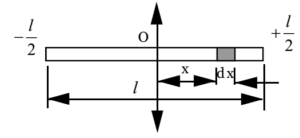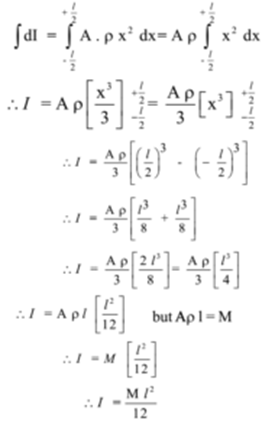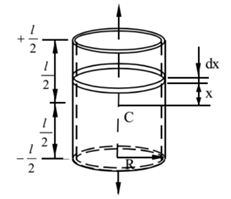Science > Physics > Rotational Motion Moment of Inertia of Standard Bodies
In this article, we shall study the method of deriving an expression for moment of inertia of a body.
Expression for Moment of Inertia of Uniform Rod About a Transverse Axis Passing Through its Centre:

Consider a thin uniform rod, of mass M, an area of cross-section A, length l, and density of material ρ. Let us consider an infinitesimal element of length dx at a distance of x from the given axis of rotation. Then its Moment of Inertia about the given axis is given by
dI = x² . dm, …… (1)
But, Mass = Volume x Density
∴ dm = A . dx . ρ …… (2)
From Equations (1) and (2)
dI = x² A . dx .ρ
∴ dI = A .ρ . x² . dx
The moment of inertia I of the rod about. the given axis is given by

This is an expression for moment of inertia of a thin uniform rod about a transverse axis passing through its centre.
Expression for Moment of Inertia of a Uniform Rod About a Transverse Axis Passing Through its End:
Method – I:

Consider a thin uniform rod, of mass M, an area of cross-section A, length l, and density of material ρ. Let us consider an infinitesimal element of length dx at a distance of x from the given axis of rotation. Then its Moment of Inertia about the given axis is given by
dI = x² . dm, …… (1)
But, Mass = Volume x Density
∴ dm = A . dx . ρ …… (2)
From Equations (1) and (2)
dI = x² A . dx .ρ
∴ dI = A .ρ . x² . dx
The moment of inertia I of the rod about. the given axis is given by

This is an expression for moment of inertia of a thin uniform rod about a transverse axis passing through its end.
Expression for the Moment of Inertia of an Annular Ring:
Consider a uniform thin annular disc of mass M having inner radius R1, outer radius R2, thickness t, and density of its material ρ. Let us assume that disc is capable of rotating about a transverse axis passing through its centre. Let us assume that the disc is made up of infinitesimally thin rings.

Consider one such ring of radius r and width dr. Moment of Inertia of such element is given, by,
dI = r² . dm ………….. (1)
But, Mass = volume × density
dm = ( 2 π r . dr . t) ρ ……… (2)
From Equation (1) and (2)
dI = r² . ( 2 π r . dr . t) ρ
dI = 2 π t ρ r³ . dr .
The moment of inertia I of the annular disc will be given by

Where M is the total mass of the annular ring.
This is an expression for moment of inertia of annular ring about a transverse axis passing through its centre.
Expression for Moment of Inertia of a Thin Uniform Disc About a Transverse Axis Passing Through its Centre and Perpendicular to its Plane:
The moment of inertia of annular ring about a transverse axis passing through its centre is given by

For the solid disc, there is no centre hole, hence R2 = R and R1 = 0

This is an expression for moment of inertia of thin uniform disc about a transverse axis passing through its centre.
Expression for Moment of Inertia of a Thin Uniform Ring About an Axis Passing through its Centre and Perpendicular to its Plane:
The moment of inertia of annular ring about a transverse axis passing through its centre is given by

For ring, the centre hole extends up to its periphery, hence R2 = R and R1 =R

This is an expression for moment of inertia of thin uniform ring about a transverse axis passing through its centre.
Expression for Moment of Inertia of a Solid Cylinder About its Geometrical Axis:

Consider a solid cylinder of mass M, length ‘’ and radius ‘r’ capable of rotating about its geometrical axis. Let ‘m be its mass per unit length.
m = M/l Hence M = m . l
A solid cylinder can be regarded as a number of thin uniform discs of infinitesimal thickness piled on top of one another. Let us consider one such disc of thickness ‘dx’ at a distance of ‘x’ from the centre C of the cylinder.
Mass of such disc is given by
Mass, dm = m.dx = (M /l). dx
The M.I. of such disc about a transverse axis (passing through C) is given by

Integrating the above expression in limits

This is an expression for M. I. of a solid cylinder about its geometrical axis.
Expression for Moment of Inertia of a Hollow Cylinder About its Geometrical Axis:

Consider a hollow cylinder of mass M, length ‘’ and radius ‘r’ capable of rotating about its geometrical axis. Let ‘m be its mass per unit length.
m = M/l Hence M = m . l
A hollow cylinder can be regarded as a number of thin uniform rings of infinitesimal thickness piled on top of one another. Let us consider one such ring of thickness ‘dx’ at a distance of ‘x’ from the centre C of the cylinder.
Mass of such ring is given by
Mass, dm = m.dx = (M/ l) dx
The M.I. of such ring about a transverse axis (passing through C) is given by

This is an expression for M. I. of a solid cylinder about its geometrical axis.
Expression for Moment of Inertia of a Solid Sphere About its Diameter (Geometrical axis):

Let us consider a solid homogeneous sphere of radius ‘R’ and mass ‘M’, capable of rotating about its diameter. Let us consider a circular strip of infinitesimal thickness ‘dx’ at a distance of x from centre ‘O’. The radius of this circular strip is PM, which is given by

This circular strip can be treated as thin disc rotating about a transverse axis passing through its centre.
The M.I. of the disc about a transverse axis passing through its centre is given by

The M.I. of the whole sphere about diameter can be obtained by integrating the above expression.


The mass of the sphere = M. Hence, the M.I. of the solid homogeneous sphere is given by

This is an expression for M.I. of a solid sphere about its diameter (Geometrical axis).
Previous Topic: Principles of Parallel and Perpendicular Axes
Next Topic: Applications of Parallel and Perpendicular Axes

2 replies on “Moment of Inertia of Standard Bodies”
very useful
Very useful for upcoming generation